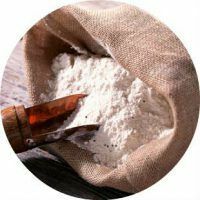
Black bugs and other insects in flour and cereals are a common problem. Appearing, they are rapidly swallowing everything, and a few days of delay can lead to the fact that it will take long to remove pests. They not only spoil the food, but also can cause poisoning and allergic reactions. Pests can be brought from a store with poor-quality products, and they are planted in places of improper storage of food. The methods of fighting bugs will be discussed later.
- pest species
- drugstore beetle
- Mukoed
- mealworms
- Food mole
- Weevils
- Abatement of
- Disposal
- Heat treatment
- Chemicals
- Traditional recipes
- Precautions
Types
pests Nowadays there are the following types of household pests:
to contents ^Bread grinder
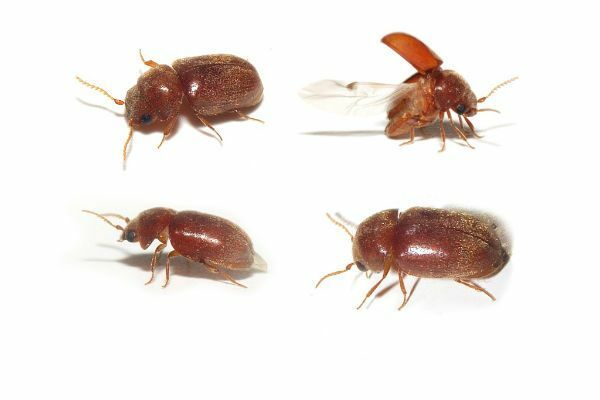
It is found in bakeries, where they forget about the basic methods of hygiene and disinfection and perfectly adaptIn almost any environment, it comes with products to the home. The size of the insect is 3 millimeters in length, it flies perfectly, which allows it to move quickly from place to place and, because of this, it is more difficult to eliminate it. Usually he eats bread, but can also eat rice, buckwheat, tea, animal feed and even an old book.
Thistle
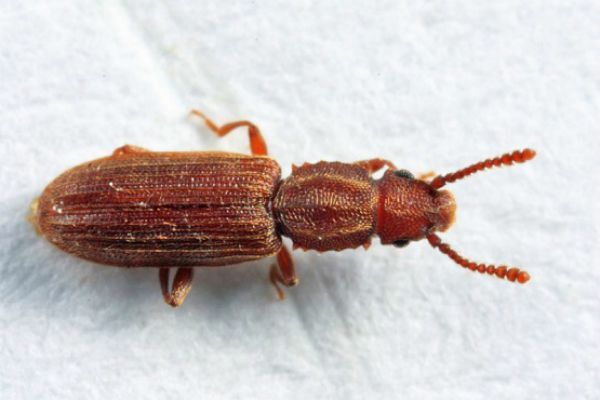
Preferred flour, cereals and cereals. He is very gluttonous, despite his tiny dimensions - 2 millimeters in length. The larva is even smaller, so it's hard to notice right away: the black dots that are found in the flour are a sign of the presence of the larvae of the mucoid in it. The beetle is very prolific, the offspring brings up to 7 times a year in large quantities. Therefore, in just a couple of months, the flour can turn into a hotbed of these insects. An ideal environment for mukoyoda - increased humidity and heat.
to contents ^Flourless Khrushchak
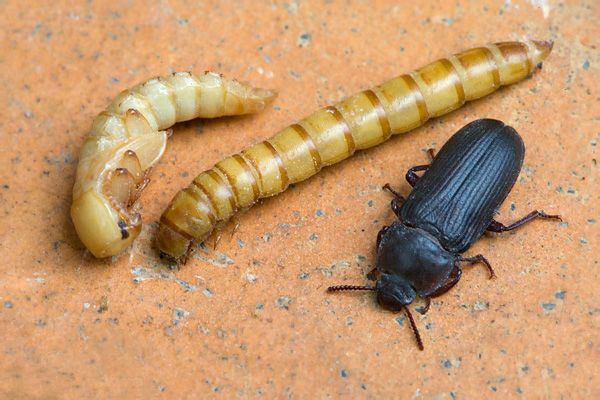
This small insect is up to 4 millimeters long, of a reddish-brown hue. He rapidly multiplies, and settles not only in flour and groats, but also in furniture, dishes. It is very difficult to bring out the hruschka, because he is unpretentious to the conditions of living and is enduring.
to table of contents ^Food mole
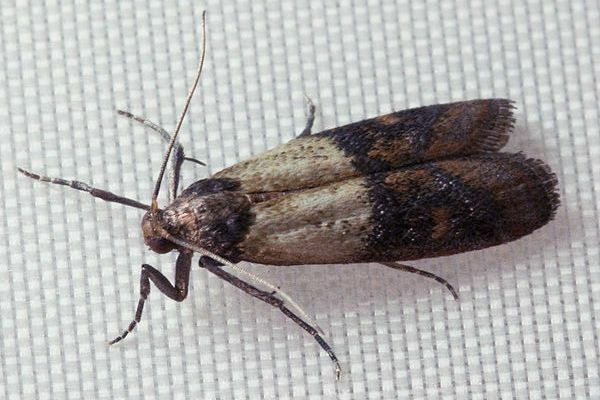
It looks like a simple moth. The length of its body does not exceed 1 centimeter. It is characterized by high fertility( over five hundred eggs in two weeks, from which caterpillars are excreted).Mole devours stocks of cereals with great speed. Her skill in hiding, flying and disguising herself under dark objects makes her almost invulnerable.
to contents ^Weevils
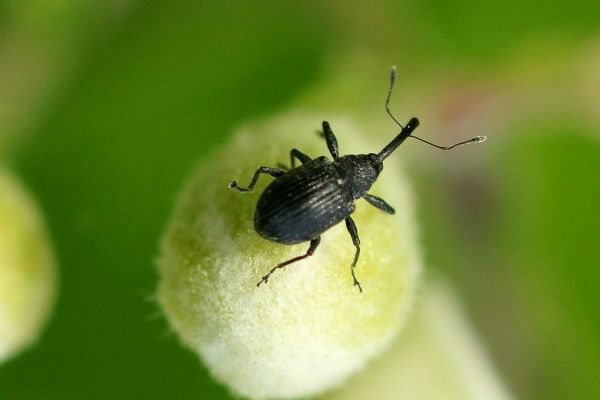
They can appear literally in all products: cereals, flour, bread, dried fruits, fruits and vegetables. They look like small bugs, about 5 millimeters in size with a long proboscis. Weevils, can fly, changing the location of the dislocation depending on the changing environmental conditions, and also easily climb the walls. Offspring pest brings up to 6 times a year. They live everywhere: remote corners of the kitchen cupboard, container with groats, bed linen, plinths, cracks.
Methods of struggle
What to do if there are bugs in flour and croups?
to contents ^Disposal of
The main method of combating a beetle is the disposal of affected supplies. Of course, it's a pity for spoiled flour or cereals, but if insects have gotten into it, it means a couple more days will pass and they will spread all over the house. Therefore it is necessary urgently, tying the package on a tight knot and putting in another package, take it to the trash.
After disposal, it is necessary to rinse the kitchen shelves and storage tanks( if any) with bleach, soda or vinegar. After treatment, always rinse the surfaces with water.
to contents ^Heat treatment
All kinds of insects perish at temperatures above +50 degrees. It can be either boiling water or steaming. This method is good for eliminating the nest of a beetle in plinths and crevices, where it is impossible to get by chemicals and sanitation.
When larvae and adults are destroyed, it is necessary to thoroughly rinse the grains( beans, beans, nuts) with water and wait until the pests have surfaced. Then, drain the water and rinse the product again so that there are no larvae left in it. Flour and small grains after heat treatment is best sifted through a sieve 2-3 times.
to contents ^Chemicals
On open kitchen surfaces it is better to use special chemicals that are abundantly sold in hardware stores. Just do not buy simple bugs from cockroaches and ants to fight the bug. In this case, you need specialized tools, for example, "Antizhuk" or "Carbophos".
"Antizhuk" helps in the fight against any beetle, whether it is cereal or woody, spoiling windows and furniture. The drug is quite effective, but before using, be sure to read the instructions, since it is toxic.
For breeding insects, you can use "Rogneda" - the strongest antiseptic, capable of destroying both weevils, mucoys, and ants and cockroaches.
Another effective means is "Lovin Fire Protection".The drug kills the beetle in the shortest possible time, but it needs to be scattered in places inaccessible to animals, since it is the strongest poison.
Folk recipes
Recipe 1.
Well helps to fight parasitestable vinegar: you need to rinse the dishes with vinegar and wipe the kitchen shelves. A sharp, caustic acetic scent will not only scare off the pest, but will also destroy it.
Recipe 2.
Mix in equal proportions boric acid, flour and powdered sugar, which serves as an excellent bait. Blend the mixture in the habitat of bugs.
Recipe 3.
Insects are afraid of the smell of bay leaf, garlic, pepper and sulfur. It is enough to put a sprig of bay leaf in the kitchen cabinet or lay out simple matches, and a reliable protection against pests will be created.
Recipe 4.
In the fight against insects, natural antiseptics such as chamomile and calendula are also effective. Possessing a powerful antiseptic, antimicrobial effect, these dry herbs can also scare away parasites, since they contain a huge amount of essential oils.
Precautions
Simple precautionary rules will help to avoid such an unpleasant problem as kitchen pests.
- In order to avoid bugs in flour and cereals, they should be stored at medium humidity in a well ventilated area;
- It should be ensured that in the kitchen cupboards there are no raw or undried products( dried fruits, vegetables, wet cereals).If there are any, then surely they will live in the swarm;
- It is mandatory to conduct regular inspection of products and shelves. Ensure that the cereals are not stored for a long time, prolonged storage is the main reason for the appearance of insects.
- Keep carnation, bay leaves and pest control off in the kitchen cupboard.
- Cereals and cereals should be stored in plastic or glass containers with a sealed lid.
- If the first signs of spoilage are detected, discard them immediately, or wash them or sift through a sieve.
- Perform general cleaning at least once a month using disinfectants.
